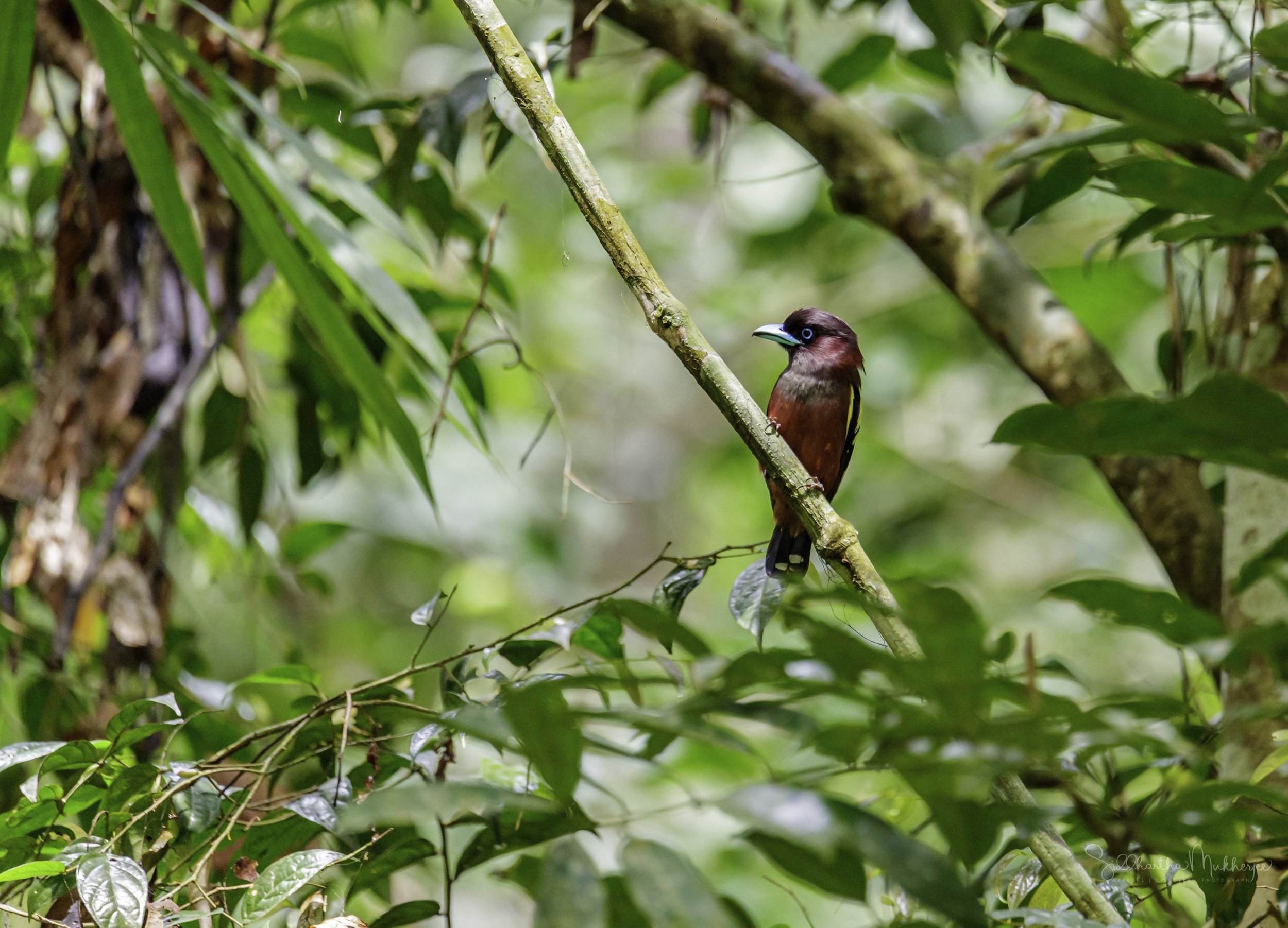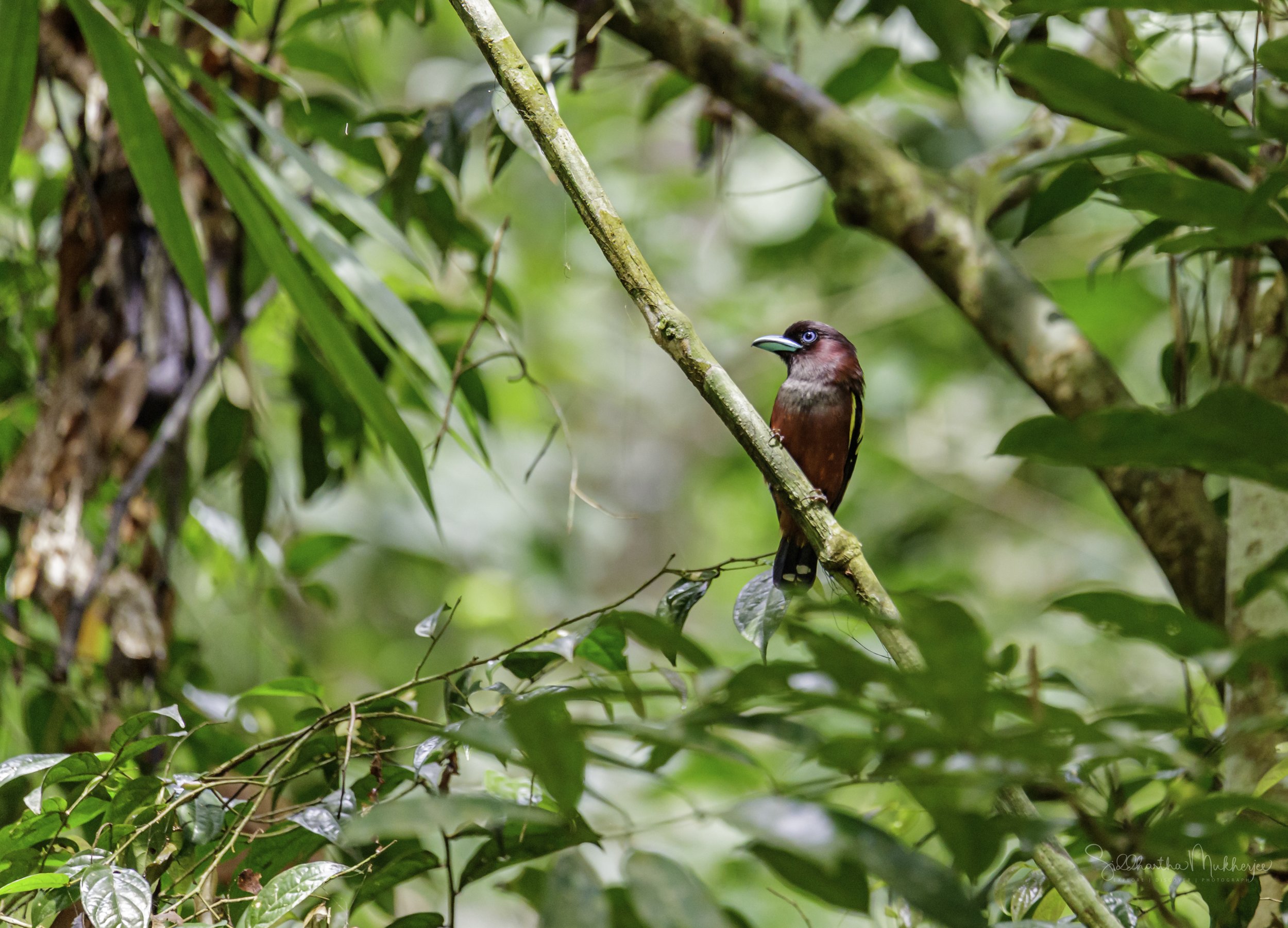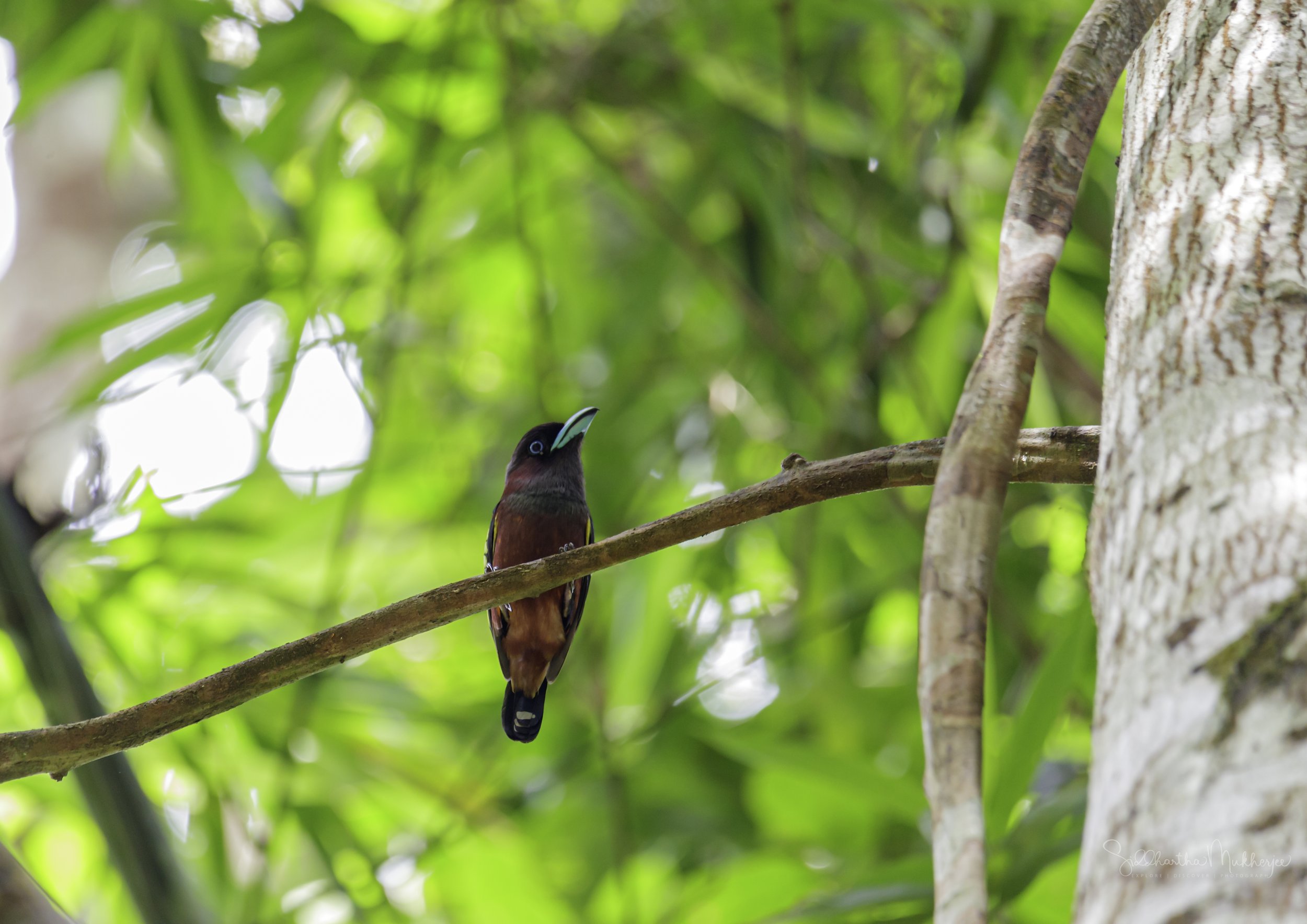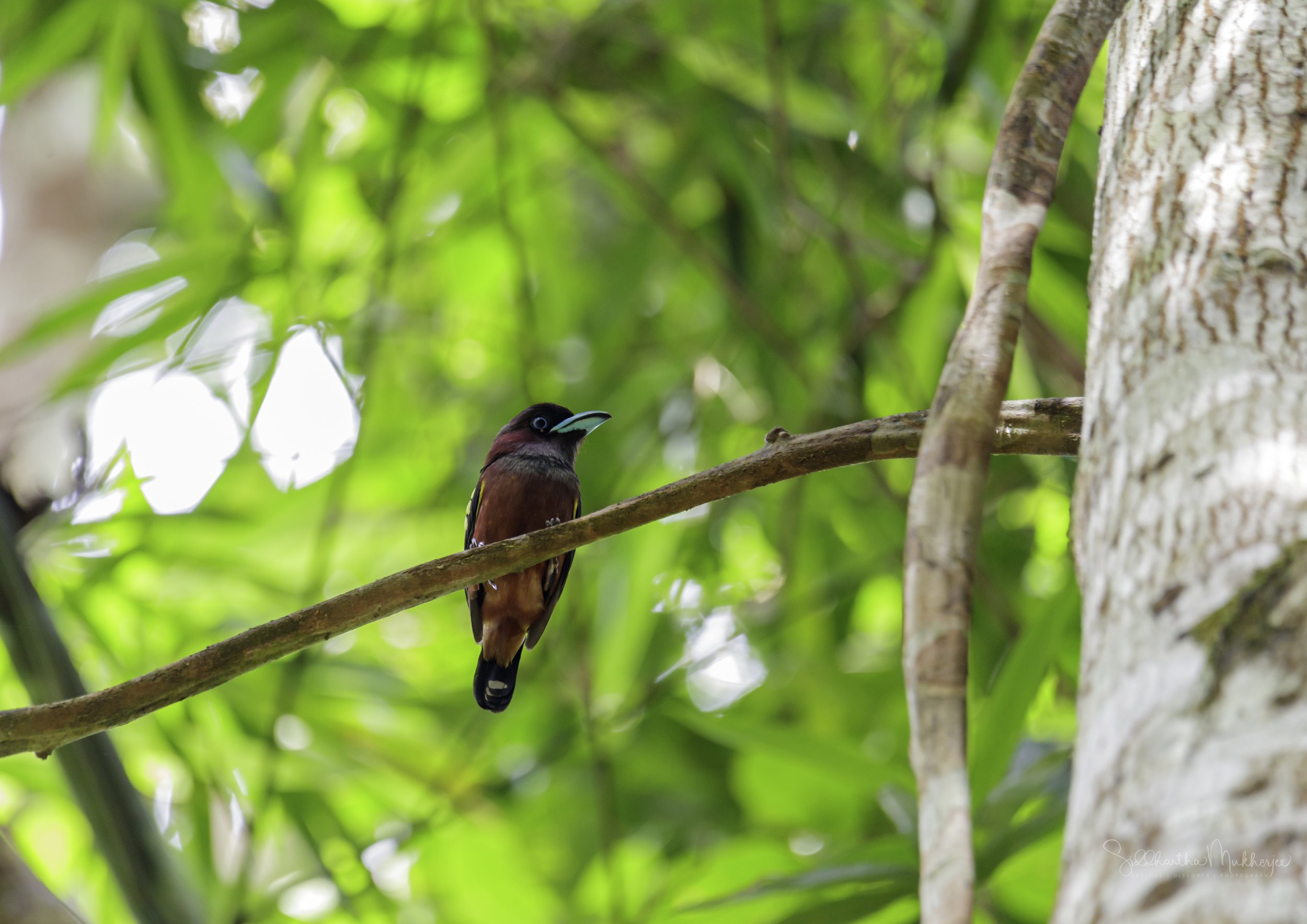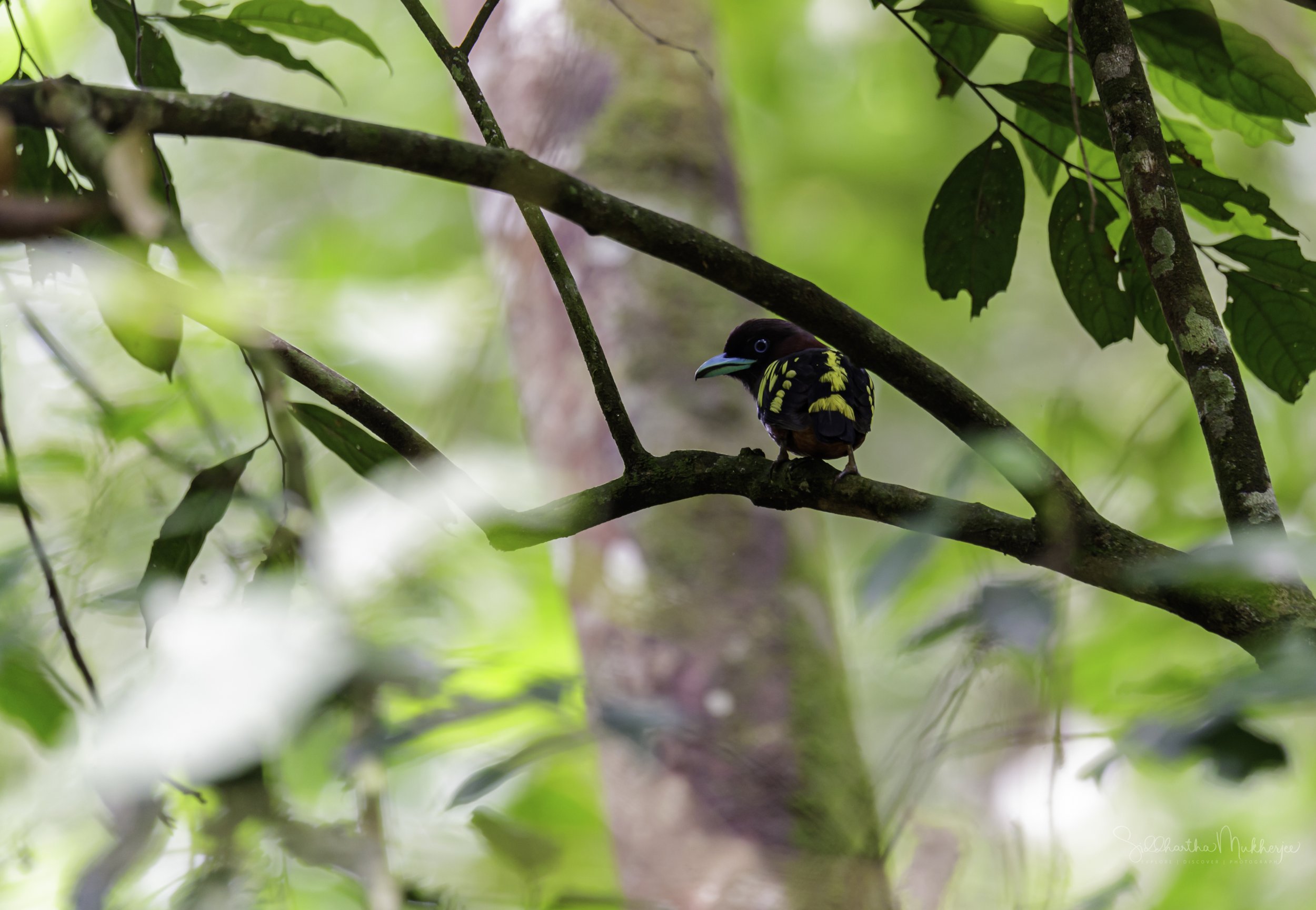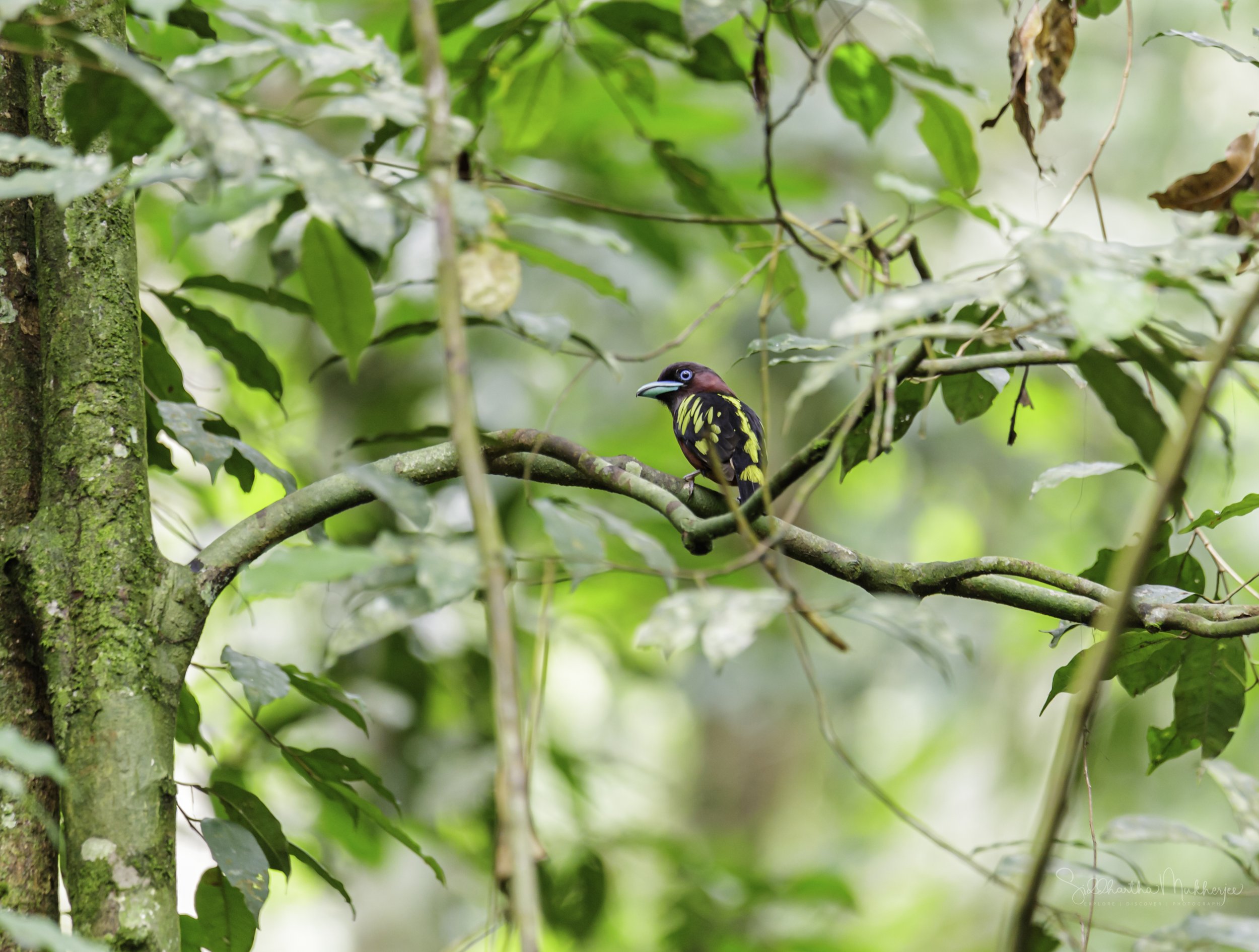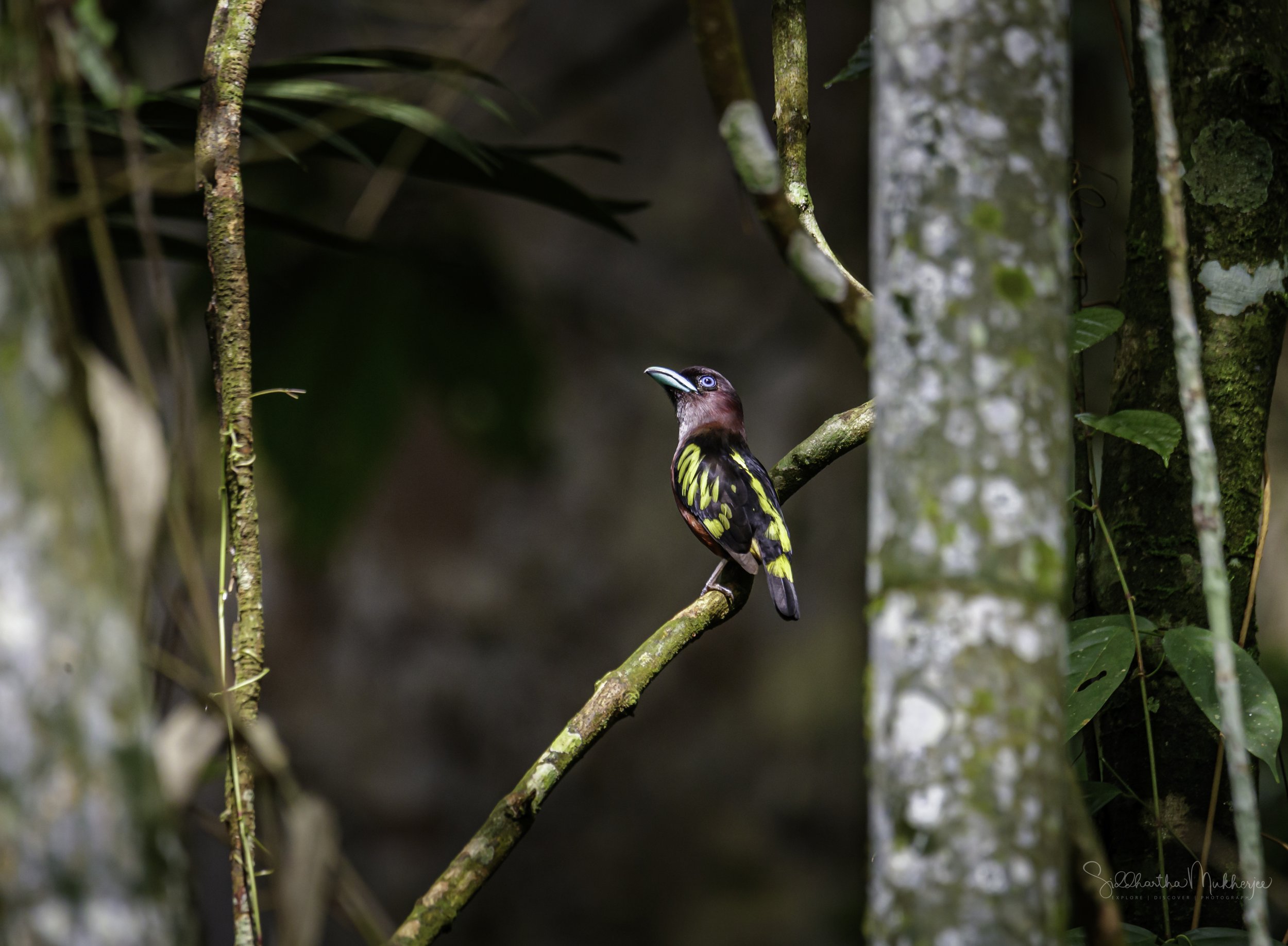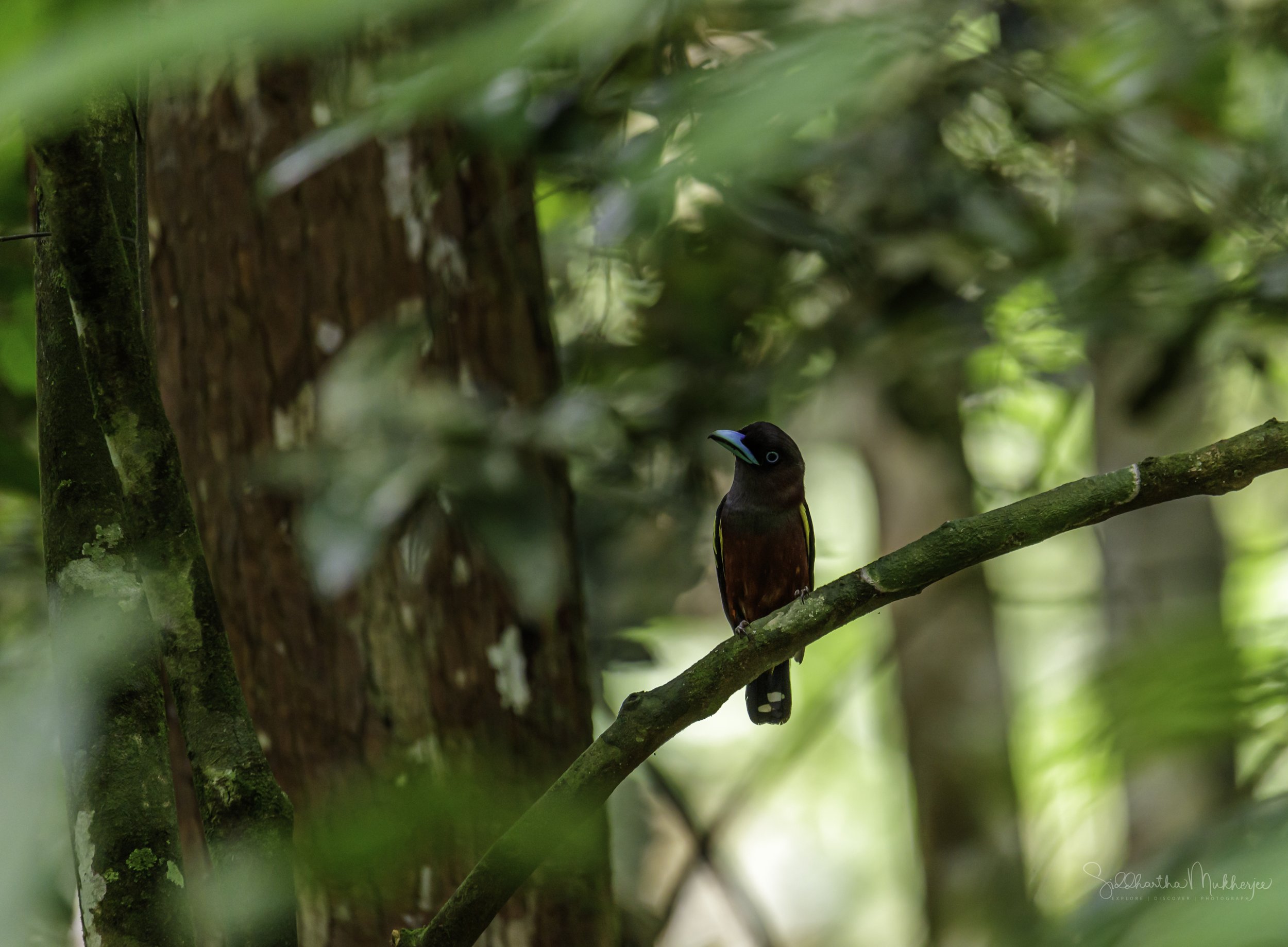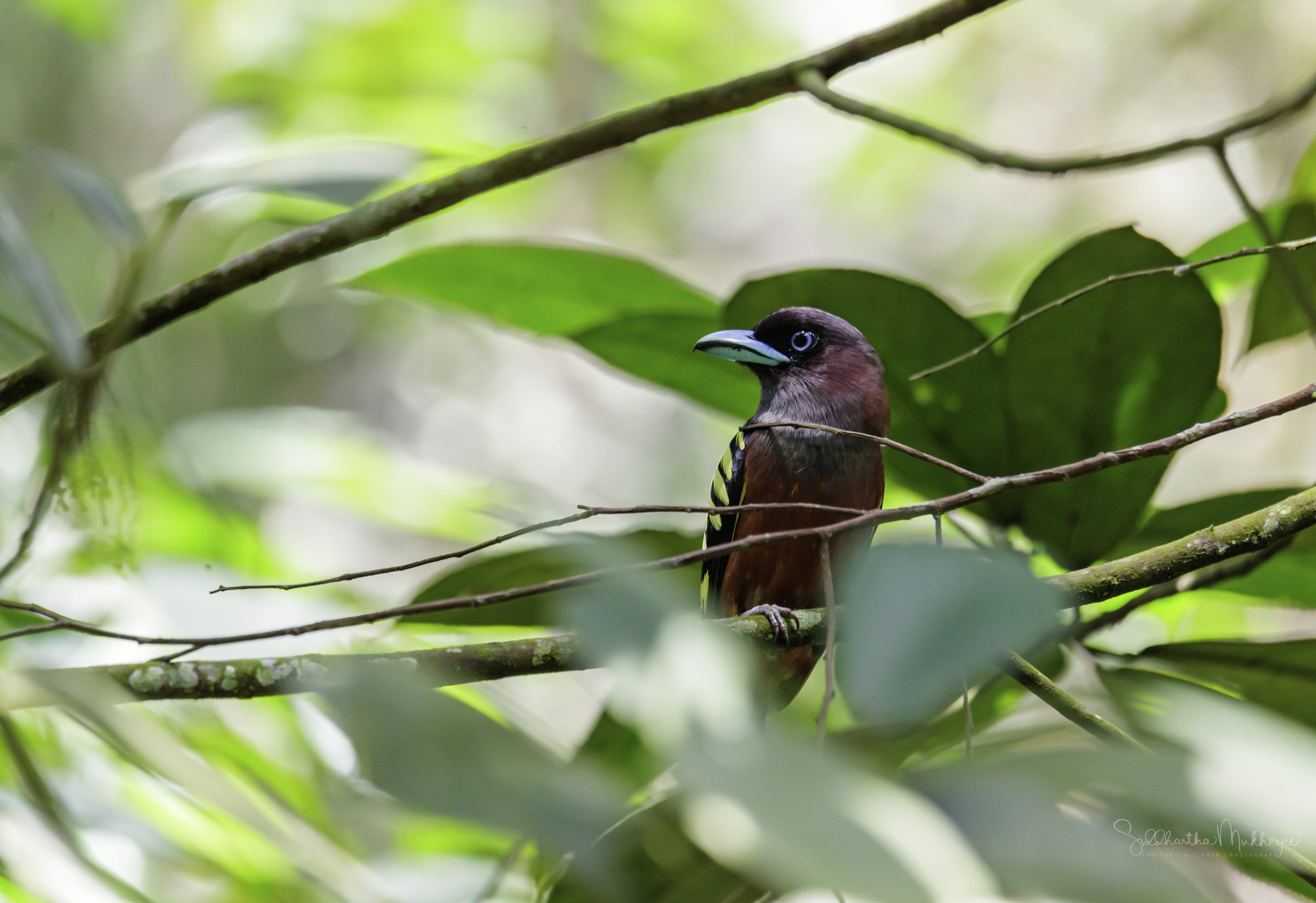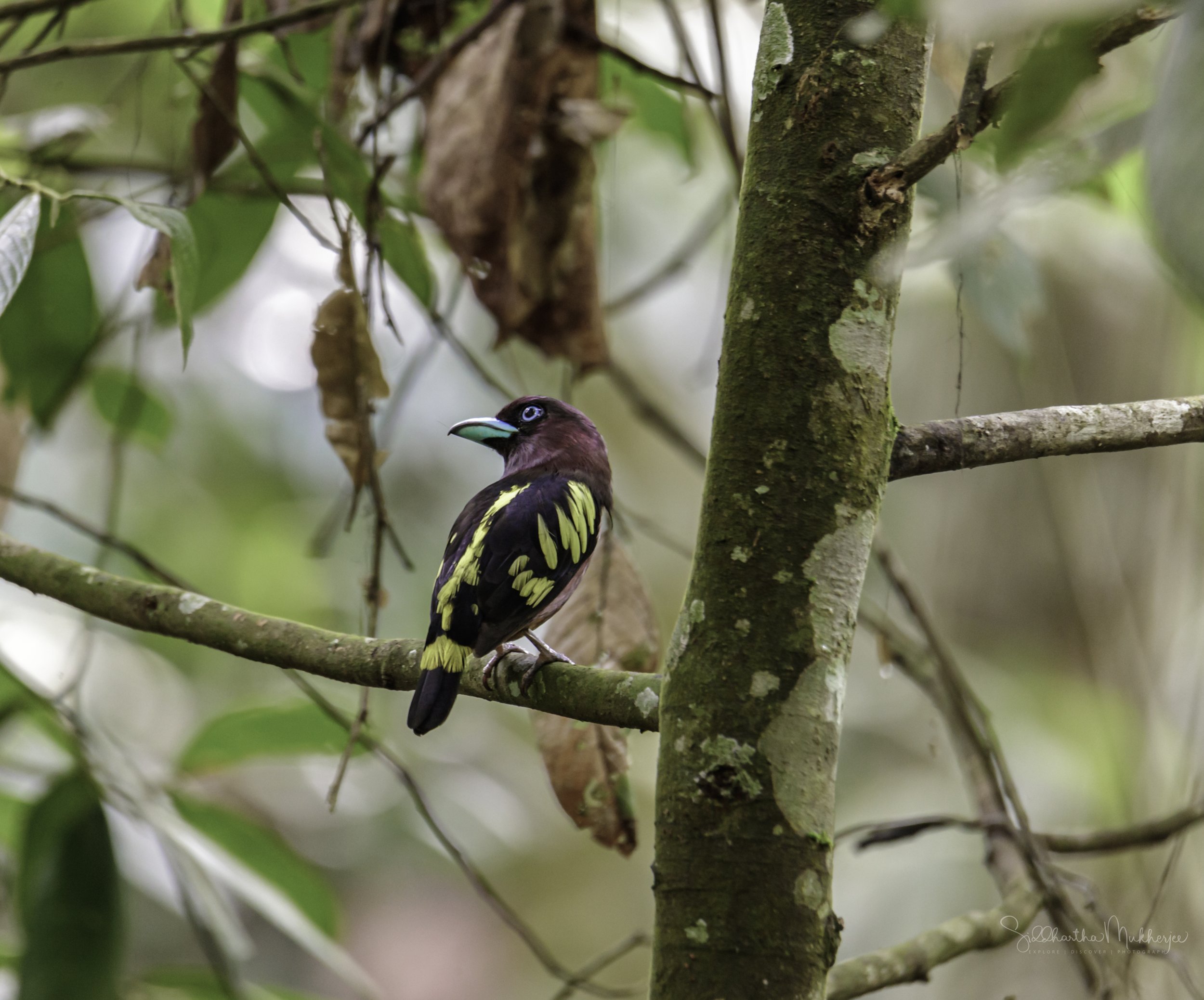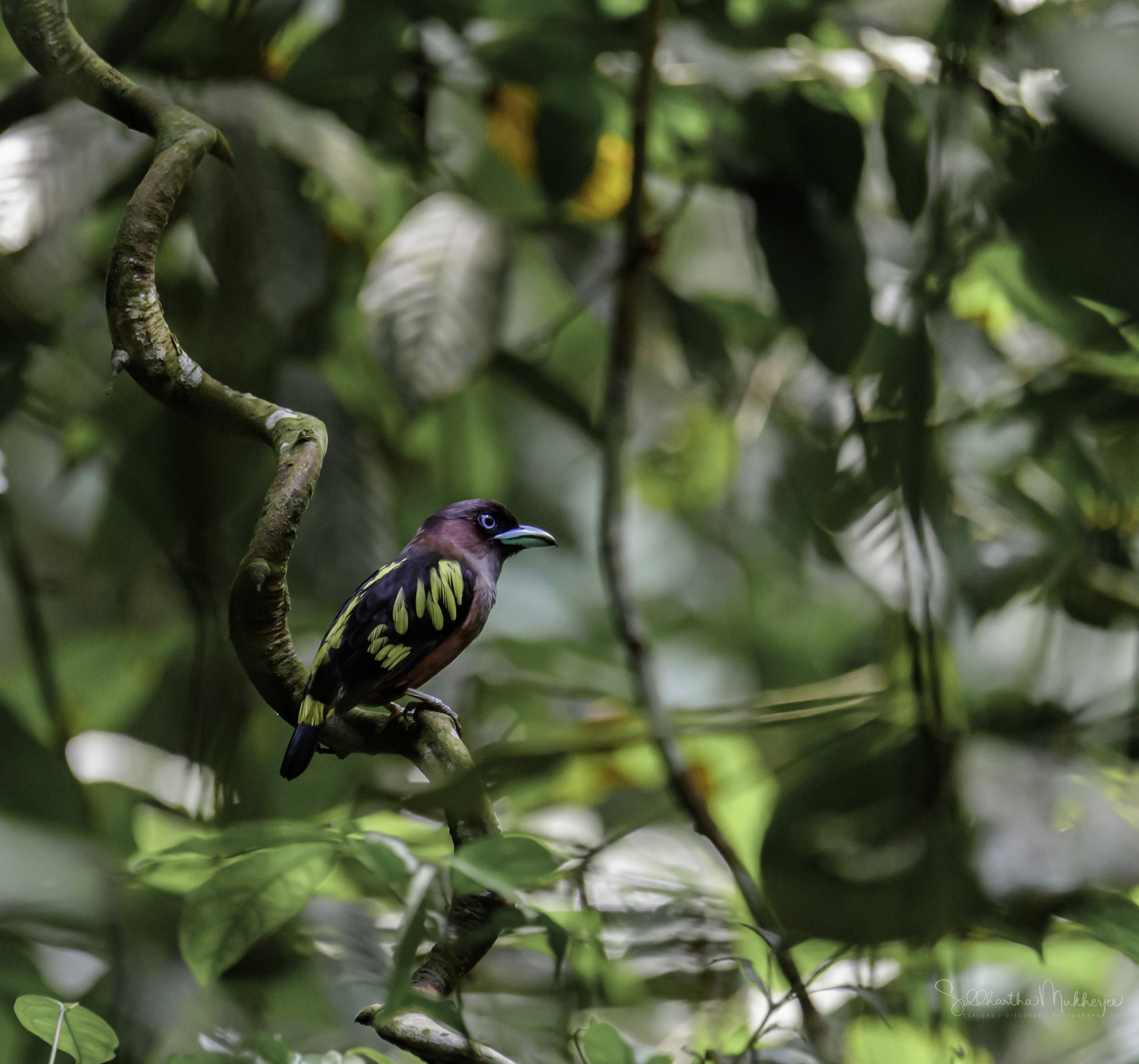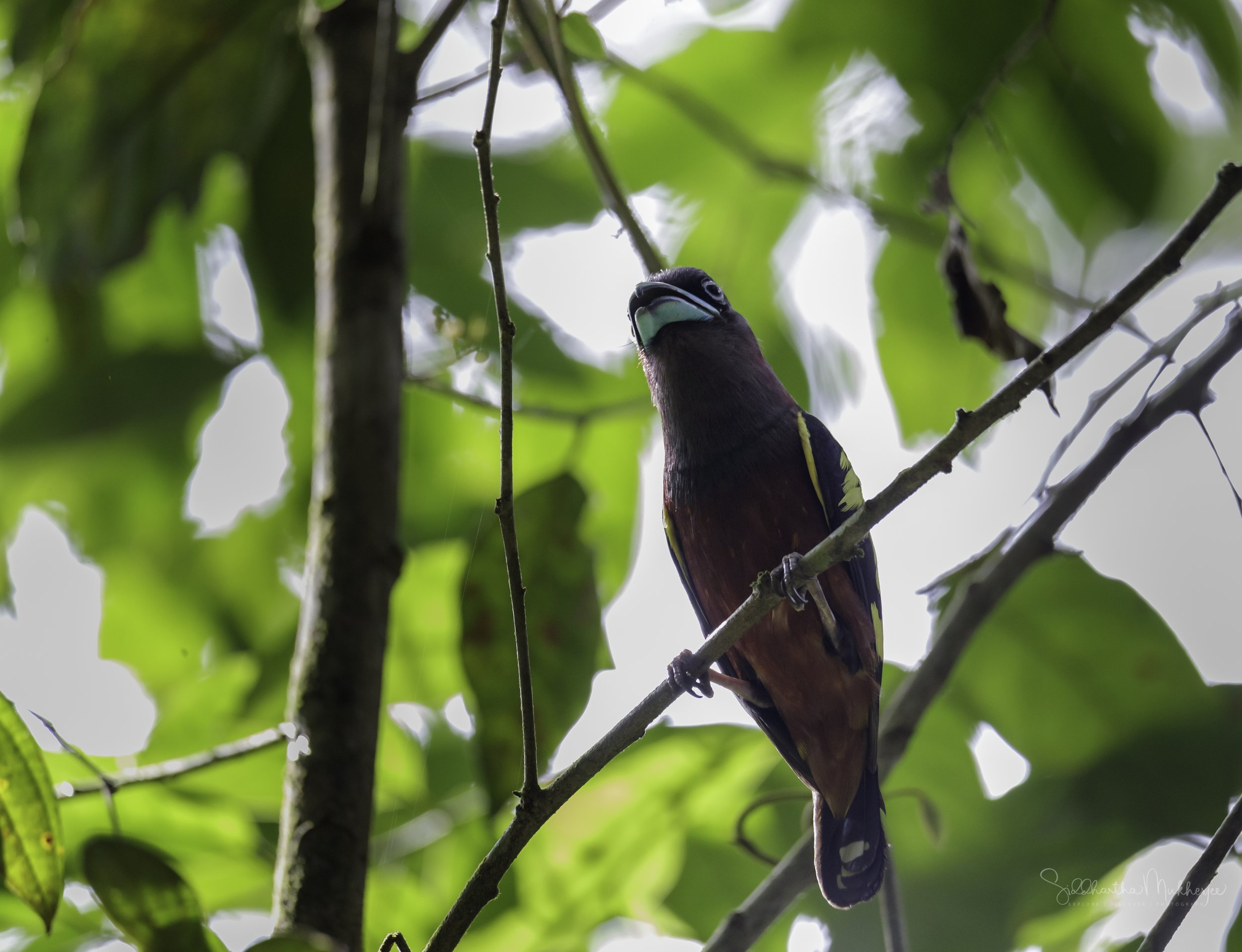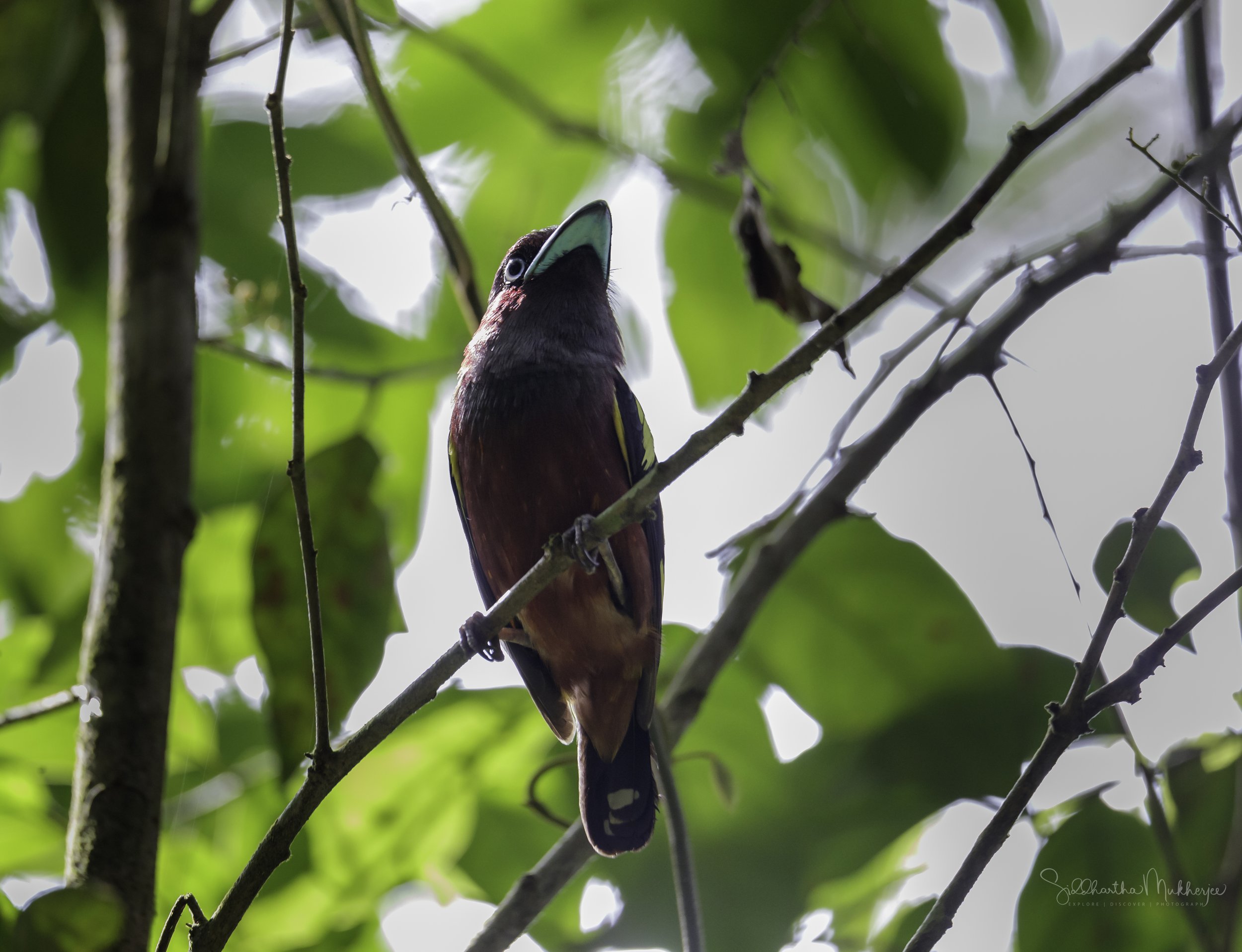Banded Broadbill
Eurylaimus javanicus
NEAR THREATENED
Sungai Congkak, Malaysia
The Eurylaimidae are a family of suboscine passerine birds that occur from the eastern Himalayas to Indonesia and the Philippines. The family previously included the sapayoa from the Neotropics, the asities from Madagascar, and the Calyptomenidae from Africa, but these are now separated into distinct families. Many of the species are brightly coloured birds that present broad heads, large eyes and a hooked, flat and broad beak. They range from 13 to 28 cms in length, and live in the dense canopies of wet forests, allowing them to hide despite their brightly coloured plumage. The plumage of the juvenile eurylaimids are similar to those of the adults, differing in being duller and shorter-winged and shorter-tailed in some cases. They are for the most part insectivorous and carnivorous.
Eurylaimids feed on a broad variety of insects and invertebrates, especially large orthopterans and mantids, as well as small vertebrates (frogs, lizards, and even fish). Exceptionally, Grauer’s Broadbill Pseudocalyptomena graueri appears to be primarily frugivorous. Most broadbills acquire food by gleaning or during short sallying flights from perches.
There are four subfamilies of broadbills: Smithornithinae (typical African broadbills), Calyptomeninae (Asian green broadbills), Eurylaiminae (assorted Asian broadbills) and Pseudocalyptomeninae (Grauer’s broadbill). There are 9 genera and 14 species of broadbills. They are thought to be closely related to pittas (Pittidae) and asities (Philepittidae). They are primarily forest birds and live in rainforests of tropical Asia and Africa. Little is known about the mating behaviour of this group. Some species are thought to be monogamous, others polygynous and some may be cooperative breeders. During displays, many broadbills make a loud trilling sound with their wings that can be heard up to 60 m away. Most species are gregarious. Some species eat primarily insects while others mainly eat fruit. Here we will see one of the Eurylaiminae (assorted Asian broadbills).
The strikingly patterned broadbills of Asia are forest canopy birds, often revealed only by their throaty staccato calls. The bold contrasting swatches of black, yellow, and red or green in their plumage often extend into a very large and brightly coloured blue or silver bill, creating a visual impact to equal that of any other passerine in these forests. Their distinctive baglike nests are suspended by a long vine or tendril far beneath overhanging branches, and often over water or near a bee or wasp nest to protect the nest from tree-bound predators. As with the green broadbills, these Asian birds have a cousin in Africa with very different appearance, but we know very little about it.
They attach their purse-shaped nests to suspended vines, and leave a tail of fibres hanging below it. This gives the nest the appearance of being random debris caught in the tree, an effect further enhanced by the birds covering the nest with lichen and spider webs. Talk about camouflage!
Based on banding recaptures, broadbills are estimated to live at least 6 years in the wild. The oldest recorded bird in captivity was 19 years old.
‡‡‡‡‡
Conservation: Six out of 15 species are on the IUCN Red List. Three species are considered Vulnerable and three Near Threatened. With no more than 10,000 individuals each, the vulnerable species all have tiny ranges that are threatened by deforestation, mining activities, and/or guerilla warfare (on Mindanao, Philippines). Deforestation of lowland forest threatens Hose's, White-head's and Black-and-yellow (Eurylaimus ochromalus) broadbills.
Large areas of the wooded habitats of Asia have been harvested or converted to agriculture, creating conservation concerns for four (44%) eurylaimid species (1 NT, 3 VU). The three vulnerable species occupy very restricted ranges in the Philippines or in the Albertine Rift mountains of Africa, and the near-threatened species is limited to three areas in the Malay Archipelago.
‡‡‡‡‡
Read more about the other Broadbills I have photographed.
‡‡‡‡‡
Sungai Congkak
About 35 kilometres from both Kuala Lumpur city center and Selangor’s Kajang town, lies the Sungai Congkak Recreational Forest, or Hutan Lipur Sungai Congkak. Also known as Chongkak Park & Resort, it is s a popular recreational forest in the Hulu Langat district of Selangor state and is managed by Tourism Selangor.
A dipterocarp rainforest that is part of the great Titiwangsa mountain range, Sungai Congkak Recreational Forest is rich in flora and fauna with meandering, crystal-clear rivers. Nestled in a cool and hilly area of Hulu Langat, the route leading to the forest passes through quaint towns and villages where the pace of life is noticeably slower.
Slightly deeper into Sungai Congkak Recreational Forest is the starting point of a challenging hiking trail to Bukit Chenuang (Chenuang Hill) which takes about an hour. Reaching an altitude of about 850 meters, the peak here provides great views of the surrounding valley. From Bukit Chenuang, one can continue hiking the trail to Bukit Batu Kumbang, which is about an hour away. The views of the Titiwangsa mountain range from the peak of Bukit Batu Kumbang make it a worthwhile hike.
Banded Broadbill (Eurylaimus javanicus friedmanni)
The banded broadbill (Eurylaimus javanicus) is a species of bird in the family Eurylaimidae. It is found in Brunei, Laos, Cambodia, Indonesia, Malaysia, Myanmar, Singapore, Thailand, and Vietnam. Its natural habitat is subtropical or tropical moist lowland forests. It is a large broadbill (21.5–23 cm), with purple, yellow and black plumage. It eats predominantly insects, including grasshoppers, crickets, katydids, various beetles, caterpillars and larvae.
It is a deep purplish-red broadbill with bold yellow patches on the wings and tail. Broad-based bill and irises are bright blue. Female is slightly duller than the male, and lacks a black line across the chest. Favours riparian and wet forests from the lowlands up into montane areas, & will visit edges, gardens, and parks. Forages in the canopy, often flying from a perch to do so. More vocal than Black-and-yellow Broadbill, giving long, drawn-out whistles and buzzing trills.
Status: Near Threatened
Here too there are two:
Range of the banded broadbill; nominate subspecies in light green and other subspecies in dark green
The Banded Broadbill (Banded) featured here which was hitherto considered conspecific with E. javanicus, although long recognized as a potential split. Races friedmanni & pallidus frequently lumped into nominate but without firm arguments, so further study is required; birds from Belitung I are named as race billitonis, but identical to some of nominate race. Four subspecies currently recognized.
The Banded Broadbill (Javan) which was hitherto treated as conspecific with E. harterti, although long recognized as a potential split, differing in its smaller size; yellow vs blue iris; narrower breastband of male; yellow vs purplish vent; paler, more evenly coloured lower breast to belly, lacking strong purplish colour and monotypic.
The Banded Broadbill (Banded) featured here can be found in South-east Myanmar, southern Thailand (south to Isthmus of Kra), and southern Indochina. It is not globally threatened but uncommon or locally common in Indochina, rare in N Thailand; locally common in suitable habitat in S part of range, but rare in NW Borneo (Brunei) and C & E Java. Treated as Near Threatened in Peninsular Malaysia. It occurs in several protected areas in Thailand, Vietnam, Peninsular Malaysia, Sumatra, and Borneo. Earlier accounts indicate that this broadbill has long been locally common, uncommon or scarce through most of its range.
‡‡‡‡‡
Related Posts

